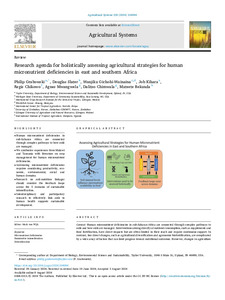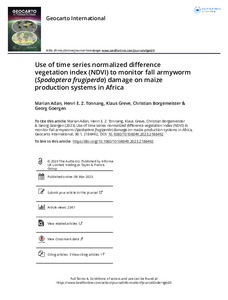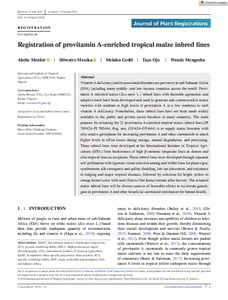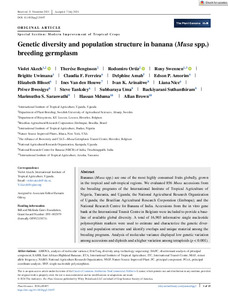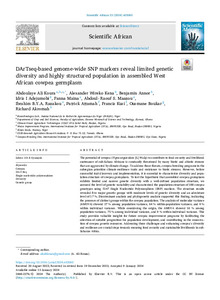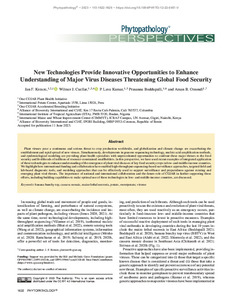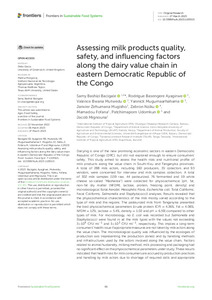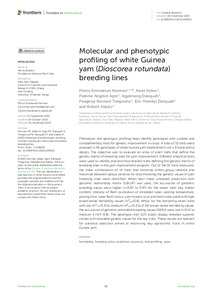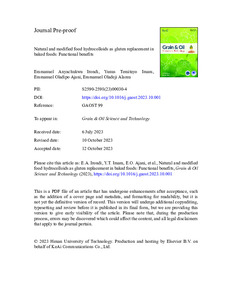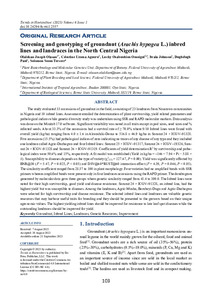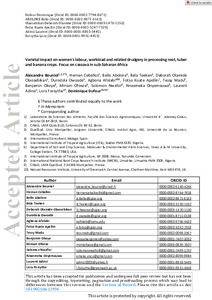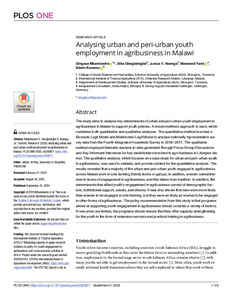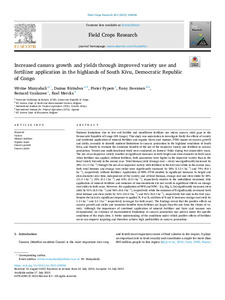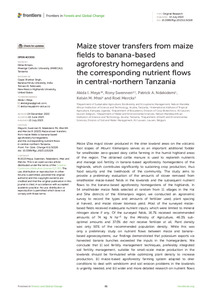Welcome to the International Institute of Tropical Agriculture Research Repository
Journal and Journal Articles: Recent submissions
Now showing items 101-120 of 5277
-
Research agenda for holistically assessing agricultural strategies for human micronutrient deficiencies in east and southern Africa
(2024-10-01)Context Human micronutrient deficiencies in sub-Saharan Africa are connected through complex pathways to soils and how soils are managed. Interventions aiming directly at nutrient consumption, such as supplements and food fortification, have direct impacts but are often limited in their reach and require continuous support. In contrast, less direct changes, such as agricultural diversification and agronomic biofortification, are complicated by a wide array of factors that can limit progress toward ... -
Use of time series normalized difference vegetation index (NDVI) to monitor fall armyworm (Spodoptera frugiperda) damage on maize production systems in Africa
(2023-03-08)Fall armyworm (FAW) Spodoptera frugiperda (J.E. Smith), damage was monitored at a regional scale using time series data in Western and Southern African countries. The study employed the normalized difference vegetation index (NDVI) computed from Landsat 8 imagery using the Google Earth Engine (GEE) using image composites for the years 2013 to 2020 for the study areas. The index was then reclassified based on the NDVI threshold values into low, sparse, moderate, and dense classes. FAW prevalence ... -
Registration of provitamin A-enriched tropical maize inbred lines
(2024)Vitamin A deficiency and its associated disorders are pervasive in sub-Saharan Africa (SSA) including many middle- and low-income countries across the world. Provitamin A-enriched maize (Zea mays L.) inbred lines with desirable agronomic and adaptive traits have been developed and used to generate and commercialize maize varieties with medium to high levels of provitamin A in a few countries to curb vitamin A deficiency. Nonetheless, these inbred lines have not been made widely available to the ... -
Genetic diversity and population structure in banana (Musa spp.) breeding germplasm
(2024)Bananas (Musa spp.) are one of the most highly consumed fruits globally, grown in the tropical and sub-tropical regions. We evaluated 856 Musa accessions from the breeding programs of the International Institute of Tropical Agriculture of Nigeria, Tanzania, and Uganda; the National Agricultural Research Organization of Uganda; the Brazilian Agricultural Research Corporation (Embrapa); and the National Research Centre for Banana of India. Accessions from the in vitro gene bank at the International ... -
DArTseq-based genome-wide SNP markers reveal limited genetic diversity and highly structured population in assembled West African cowpea germplasm
(2024-03)The potential of cowpea (Vigna unguiculata [L] Walp) to contribute to food security and livelihood sustenance of sub-Sahara Africans is constantly threatened by many biotic and abiotic stresses that are aggravated by climate change. To address these threats, cowpea breeding programs in the subregion prioritize climate-resilience traits and resistance to biotic stresses. However, before successful trait discovery and implementation, it is essential to characterize diversity and population structure ... -
Phenotypic diversity within Ugandan yam (Dioscorea species) germplasm collection
(2022-12-19)A proper understanding of the diversity of the available germplasm is an initial step for the genetic improvement of a crop through breeding. However, there is limited information on the diversity of Uganda’s yam germplasm. The study sought to characterize the diversity of yam germplasm utilized for decades in Uganda together with germplasm recently introduced from West Africa using phenotypic traits. A germplasm collection of 291 genotypes was characterized using 28 phenotypic traits. Data were ... -
Population structure and genetic diversity of rice (Oryza sativa L.) germplasm from the Democratic Republic of Congo (DRC) using DArTseq-Derived Single Nucleotide Polymorphism (SNP)
(2023-07-19)Understanding the genetic diversity and population structure of rice is crucial for breeding programs, conservation efforts, and the development of sustainable agricultural practices. This study aimed to assess the genetic diversity and population structure of 94 rice (Oryza sativa L.) genotypes from the Democratic Republic of Congo using a set of 8389 high-quality DArTseq-based single nucleotide polymorphism (SNP) markers. The average polymorphic information content (PIC) of the markers was 0.25. ... -
New technologies provide innovative opportunities to enhance understanding of major virus diseases threatening global food security
(2023-09)Plant viruses pose a continuous and serious threat to crop production worldwide, and globalization and climate change are exacerbating the establishment and rapid spread of new viruses. Simultaneously, developments in genome sequencing technology, nucleic acid amplification methods, and epidemiological modeling are providing plant health specialists with unprecedented opportunities to confront these major threats to the food security and livelihoods of millions of resource-constrained smallholders. ... -
Assessing milk products quality, safety, and influencing factors along the dairy value chain in eastern Democratic Republic of the Congo
(2023-11-01)Dairying is one of the new promising economic sectors in eastern Democratic Republic of Congo (DRC), but still not explored enough to ensure consumers' safety. This study aimed to assess the health risks and nutritional profile of milk products along the value chain in South-Kivu and Tanganyika provinces. A total of 288 milk actors, including 160 producers, 35 collectors and 93 vendors, were concerned for interview and milk samples collection. A total of 302 milk samples (159 raw, 44 pasteurized, ... -
Molecular and phenotypic profiling of white Guinea yam (Dioscorea rotundata) breeding lines
(2023-11)Phenotypic and genotypic profiling helps identify genotypes with suitable and complementary traits for genetic improvement in crops. A total of 32 traits were assessed in 36 genotypes of white Guinea yam established in a 6 × 6 triple lattice design. The objective was to evaluate an array of plant traits that define the genetic merits of breeding lines for yam improvement. Different analytical tools were used to identify and prioritize relevant traits defining the genetic merits of breeding lines ... -
Natural and modified food hydrocolloids as gluten replacement in baked foods: functional benefits
(2023-12)Gluten, the protein responsible for the superior viscoelastic properties of refined wheat flour dough over gluten-free cereals, causes celiac disease in people susceptible to gluten-allergy. Moreover, the sustainability of using wheat flour in baked foods is threatened by its high cost, especially in countries that depend on imported wheat for their bakery industry. Research has shown that hydrocolloids serve as gluten replacements in baked foods, in response to these challenges. Food hydrocolloids ... -
Studies on genetic polymorphism of improved cowpea varieties using Simple Sequence Repeats (SSR) marker
(2023-07-06)Background and Objective: Several new varieties are released from breeding programs targeted at solving specific threats to cowpea production in Nigeria. As part of efforts to promote crop improvement, this study was carried out to determine the level of genetic polymorphism and phylogenetic relationship that exists among four selected improved varieties of cowpea (SAMPEA-14, SAMPEA-15, SAMPEA-17 and SAMPEA-18) using ten SSR molecular markers. Materials and Methods: The DNA was extracted from 14 ... -
Screening and genotyping of groundnut (Arachis hypogea L.) inbred lines and landraces in the North Central Nigeria
(2023-09-21)The study evaluated 33 accessions of groundnut in the field, consisting of 23 landraces from Nasarawa communities in Nigeria and 10 inbred lines. Assessment entailed the determination of plant survivorship, yield related parameters and pathological indices while genetic diversity study was undertaken using SSR and RAPD molecular markers. Data analysis was done on the Minitab 17.0 software. Significant variability was noted in all traits except in pod sizes, seed sizes and % infected seeds. About ... -
Sensory characterization of the perceived quality of East African highland cooking bananas (matooke)
(2023-04-07)BACKGROUND It has recently become increasingly evident that banana projects in Uganda need to consider consumer preferences as part of the breeding process to increase the acceptability of new cultivars. A trained panel used quantitative descriptive analysis (QDA) as a tool to assess the sensory characteristics of 32 cooking bananas (matooke). The aim was to investigate which sensory characteristics best describe matooke. RESULTS Fourteen descriptors were generated. The preferred attributes of ... -
Varietal impact on women's labour, workload and related drudgery in processing root, tuber and banana crops: focus on cassava in sub-Saharan Africa
(2024-06)Roots, tubers and cooking bananas are bulky and highly perishable. In Africa, except for yams, their consumption is mainly after transport, peeling and cooking in the form of boiled pieces or dough, a few days after harvest. To stabilize, better preserve the products and, in the case of cassava, release toxic cyanogenic glucosides, a range of intermediate products have been developed, mainly for cassava, related to fermentation and drying after numerous processing operations. This review highlights, ... -
Analysing urban and peri-urban youth employment in agribusiness in Malawi
(2023-09-21)The study aims to analyse key determinants of urban and peri-urban youth employment in agribusiness in Malawi to support youth policies. A mixed-methods approach is used, which combines both quantitative and qualitative analyses. The quantitative method involved a Bivariate Logit Model and Multinomial Logit Model to analyse nationally representative survey data from the Fourth Integrated Household Survey in 2016–2017. The qualitative method employed thematic analysis to data generated through Focus ... -
Increased cassava growth and yields through improved variety use and fertilizer application in the highlands of South Kivu, Democratic Republic of Congo
(2023-10-15)Nutrient limitations due to low soil fertility and insufficient fertilizer use widen cassava yield gaps in the Democratic Republic of Congo (DR Congo). This study was undertaken to investigate firstly the effects of variety and combined application of mineral fertilizer and organic (farm yard manure, FYM) inputs on cassava growth and yields, secondly to identify nutrient limitations to cassava production in the highland conditions of South Kivu, and thirdly to evaluate the economic benefits of the ... -
Combining ability of extra-early maturing provitamin A maize (Zea mays L.) inbred lines and performance of derived hybrids under Striga hermonthica infestation and low soil nitrogen
(2023-02-24)Low soil nitrogen (low-N), Striga hermonthica infestation and vitamin A deficiency in normal endosperm maize are major challenges confronting maize production and nutrition of the people of sub-Saharan Africa (SSA). Development of pro-vitamin A (PVA) maize hybrids with combined resistance/tolerance to the two stress factors is crucial in mitigating the food insecurity and nutrition challenges resulting from low-N deficiency and Striga infestation. One hundred and fifty hybrids plus six hybrid ... -
Maize stover transfers from maize fields to banana-based agroforestry homegardens and the corresponding nutrient flows in central-northern Tanzania
(2023-07-13)Maize (Zea mays) stover produced in the drier lowland areas on the volcanic foot slopes of Mount Kilimanjaro serves as an important additional fodder for smallholder zero-grazed dairy cattle farming in the humid highland areas of the region. The obtained cattle manure is used to replenish nutrients and manage soil fertility in banana-based agroforestry homegardens of the highlands, which contributes significantly to sustaining crop production, thus food security and the livelihoods of the community. ... -
Climate change adaptation strategies and its impact on household vulnerability to food insecurity: a micro-level evidence from Southwest Ethiopia
(2024-07-06)Smallholder farmers in Ethiopia face increasing challenges from climate change and variability, which threaten their food security and livelihoods. This study examines how adopting single and combined climate change adaptation practices affects their vulnerability to food insecurity in Bench Maji Zone, southwest Ethiopia. Through multistage sampling, data was gathered from 390 rural households in four climate-prone districts. The study examines the impacts resulting from both individual and combined ...

